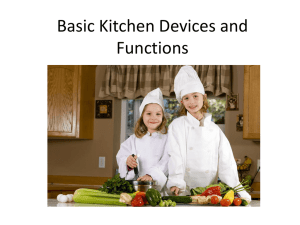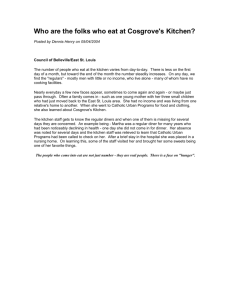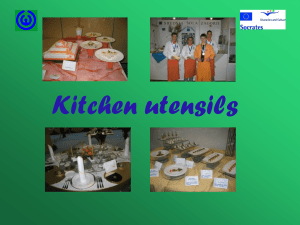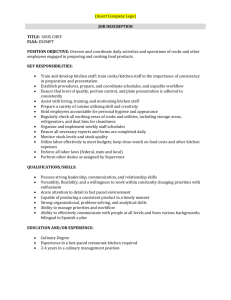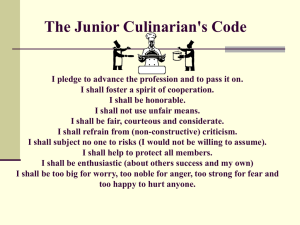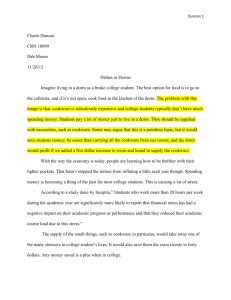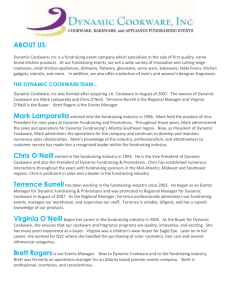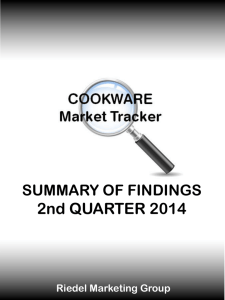Ch 19 Outline
advertisement
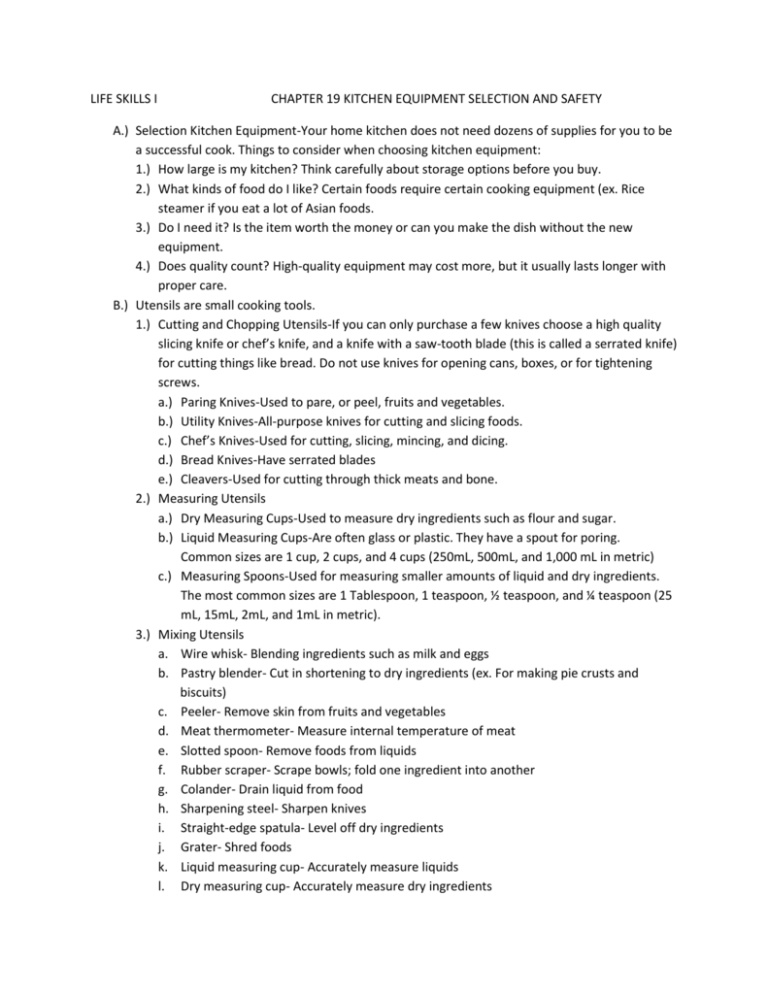
LIFE SKILLS I CHAPTER 19 KITCHEN EQUIPMENT SELECTION AND SAFETY A.) Selection Kitchen Equipment-Your home kitchen does not need dozens of supplies for you to be a successful cook. Things to consider when choosing kitchen equipment: 1.) How large is my kitchen? Think carefully about storage options before you buy. 2.) What kinds of food do I like? Certain foods require certain cooking equipment (ex. Rice steamer if you eat a lot of Asian foods. 3.) Do I need it? Is the item worth the money or can you make the dish without the new equipment. 4.) Does quality count? High-quality equipment may cost more, but it usually lasts longer with proper care. B.) Utensils are small cooking tools. 1.) Cutting and Chopping Utensils-If you can only purchase a few knives choose a high quality slicing knife or chef’s knife, and a knife with a saw-tooth blade (this is called a serrated knife) for cutting things like bread. Do not use knives for opening cans, boxes, or for tightening screws. a.) Paring Knives-Used to pare, or peel, fruits and vegetables. b.) Utility Knives-All-purpose knives for cutting and slicing foods. c.) Chef’s Knives-Used for cutting, slicing, mincing, and dicing. d.) Bread Knives-Have serrated blades e.) Cleavers-Used for cutting through thick meats and bone. 2.) Measuring Utensils a.) Dry Measuring Cups-Used to measure dry ingredients such as flour and sugar. b.) Liquid Measuring Cups-Are often glass or plastic. They have a spout for poring. Common sizes are 1 cup, 2 cups, and 4 cups (250mL, 500mL, and 1,000 mL in metric) c.) Measuring Spoons-Used for measuring smaller amounts of liquid and dry ingredients. The most common sizes are 1 Tablespoon, 1 teaspoon, ½ teaspoon, and ¼ teaspoon (25 mL, 15mL, 2mL, and 1mL in metric). 3.) Mixing Utensils a. Wire whisk- Blending ingredients such as milk and eggs b. Pastry blender- Cut in shortening to dry ingredients (ex. For making pie crusts and biscuits) c. Peeler- Remove skin from fruits and vegetables d. Meat thermometer- Measure internal temperature of meat e. Slotted spoon- Remove foods from liquids f. Rubber scraper- Scrape bowls; fold one ingredient into another g. Colander- Drain liquid from food h. Sharpening steel- Sharpen knives i. Straight-edge spatula- Level off dry ingredients j. Grater- Shred foods k. Liquid measuring cup- Accurately measure liquids l. Dry measuring cup- Accurately measure dry ingredients m. n. o. p. q. r. Measuring spoons- Accurately measure small amounts of food Sifter- Add air to remove lumps from dry ingredients Wooden spoon- Beat, stir, and mix foods, or stir hot food Tongs- Lift and turn hot foods Wire cooling rack- Cool cookies, cakes, and breads Cutting board-serve as a base for your cutting and keep knife blade sharp and counters in good shape. Clear plastic boards DO NOT promote bacteria growth. s. Kitchen shears-Sturdy scissors kept in the kitchen and used for cutting vegetables, pastry, poultry, and meat. C.) Cookware and Bakeware 1.) Cookware includes pots, pans, and other containers for use on top of the range, in the oven, or in the microwave. 2.) Plastic cookware can only be used in the microwave. Most glass cookware can be used in both the oven and the microwave 3.) When buying cookware, be sure that the bottoms of the pots and pans are heavy and flat, the handles are riveted to the pan, and the covers fit securely. 4.) Types of Cookware and Bakeware a.) Saucepans and stockpots-Are deep pans that come in a variety of sizes. b.) Cake pans-Come in different shapes and sizes and can be made of glass, metal, or silicone. c.) Loaf pans-Come in different sizes and are used for breads and meatloaves. d.) Casseroles-also called baking dishes. e.) Skillets-Shallow pans with long handles. f.) Pie Pans-Are round and come in different sizes and depths. g.) Baking Sheets-Are rectangular, low-sided pans. h.) Muffin Pans-Have from 6 to 12 individual cups to hold muffins or cupcakes. i.) Custard cups-Are made from heatproof glass. D.) Small Kitchen Appliances- includes mixers, coffeemakers, blenders, food processors, and indoor grills. 1.) Small appliances are generally powered by electricity. They are portable, so you can move them from place to place, which allows you to use and store them in different areas of the kitchen. 2.) Some appliances are immersible, which means that the entire appliance can be put safely into water to be washed. 3.) Using small appliances safely 1.) Follow instructions-Before using appliances, read the instruction manual so you know how to operate it correctly. 2.) Use caution with blades-Wash separately and never put utensils or your hands near the blades while the appliance is running. 3.) Keep cords under control-Avoid letting appliance cords dangle over the edge of countertops or tables. 4.) Make sure your hands are dry-Dry your hands before handling equipment 5.) Unplug with care-Pull in the plug itself, not the cord. 6.) Keep utensils our of toasters-Do not stick metal items into the toaster and unplug the toaster before trying to shake the bread loose. E.) Major Kitchen Appliances-includes a gas or electric range, refrigerator, microwave ovens, convection ovens, dishwashers, freezers, trash compactors, and garbage disposals. Large appliances are considered major purchases. 1.) Refrigerators-Keep food fresh and healthful. To do that, a refrigerator temperature must be 40 degrees Farenheit or lower. 2.) Ranges-If a grease ire starts in a pan smother it with a pan cover, salt, or baking soda. Do not use flour or water. Always keep a fire extinguisher in the kitchen and know how to use it. 3.) Standard and Convection Ovens- Convection ovens have a fan in the back, which moves hot air around. The rapid air-flow equalizes temperatures throughout the oven. This allows most convection ovens to cook up to twice as fast as standard ovens. 4.) Microwave Ovens-Microwave ovens use energy waves called microwaves. Rotating food during cooking allows the food to cook evenly in the microwave. Never use anything made of metal or that has metal parts in the microwave oven. This includes aluminum foil. A process called superheating can cause an explosion. Superheating occurs when a liquid’s container does not allow bubbles to form, causing the liquid to explode. F.) Keep Kitchen Equipment Clean 1.) Dishcloths and Sponges-Wash sponges along with dishes in the dishwasher 2.) Dishtowels-Wash and dry frequently to prevent build up of bacteria. 3.) Cleaning Pads-Use to remove stuck-on food from cookware and utensils. 4.) Brushes-Vegetable brushes are used to clean potato skins. G.) Keep the Kitchen Child-Safe 1.) Supervise Constantly-Keep children a safe distance from hot items. Watch out for children when you move hot or heavy items. 2.) Keep tempting objects out of reach-Cords and knives could be hazardous. 3.) Use placemats-Placemats are a safer choice than tablecloths that children could pull on causing hot food to spill. 4.) Prevent falls-Wipe up spills immediately. Never leave anything in the floor that someone might trip over.
